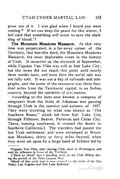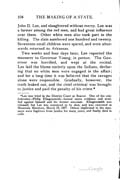
[p. 103]
The Mountain Meadows Massacre. At this very time was perpetrated, in a far-away corner of the Territory, that horrible deed, the Mountain Meadows Massacre, the most deplorable event in the history of Utah. It occurred on the eleventh of September, while Captain Van Vliet was still at Salt Lake City; but the news did not reach this point until nearly three weeks later, and even then the awful tale was not fully told. It was not a day of railroads and telegraphs, and the scene of the massacre was three hundred miles from the Territorial capital, in an Indian country, beyond the outskirts of civilization.
According to the facts now known, a company of emigrants from the State of Arkansas was passing through Utah in the summer and autumn of 1857. They were traveling by what was known as "The Southern Route," which led from Salt Lake City through Fillmore, Beaver, Parowan and Cedar City. There, turning southwest, it crossed the desert to Southern California.‡ The travelers had passed the last Utah settlement, and were encamped at Mountain Meadows, thirty or forty miles beyond, when they were set upon by a large band of Indians led by

[p. 104]
John D. Lee, and slaughtered without mercy. Lee was a farmer among the red men, and had great influence over them. Other white men also took part in the killing. The slain numbered one hundred and twenty. Seventeen small children were spared, and were afterwards returned to Arkansas.
Two weeks and four days later, Lee reported the massacre to Governor Young, in person. The Governor was horrified, and wept at the recital. Lee laid the blame entirely upon the Indians, declaring that no white men were engaged in the affair; and for a long time it was believed that the savages alone were responsible. Gradually, however, the truth leaked out, and the chief criminal was brought to justice and paid the penalty of his crime.*